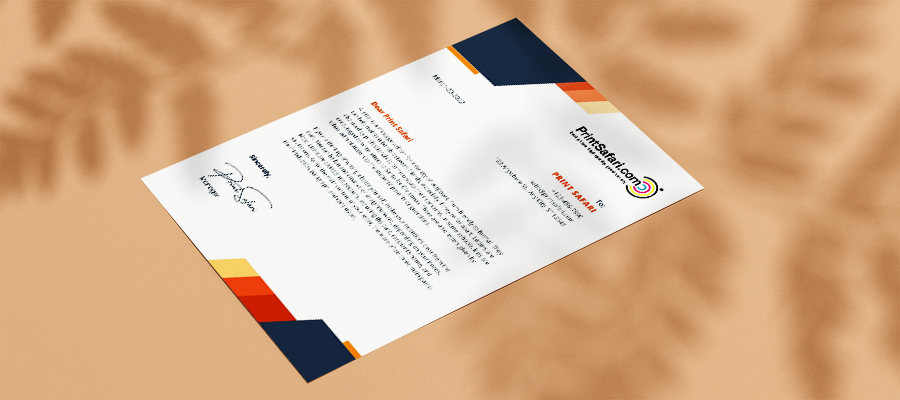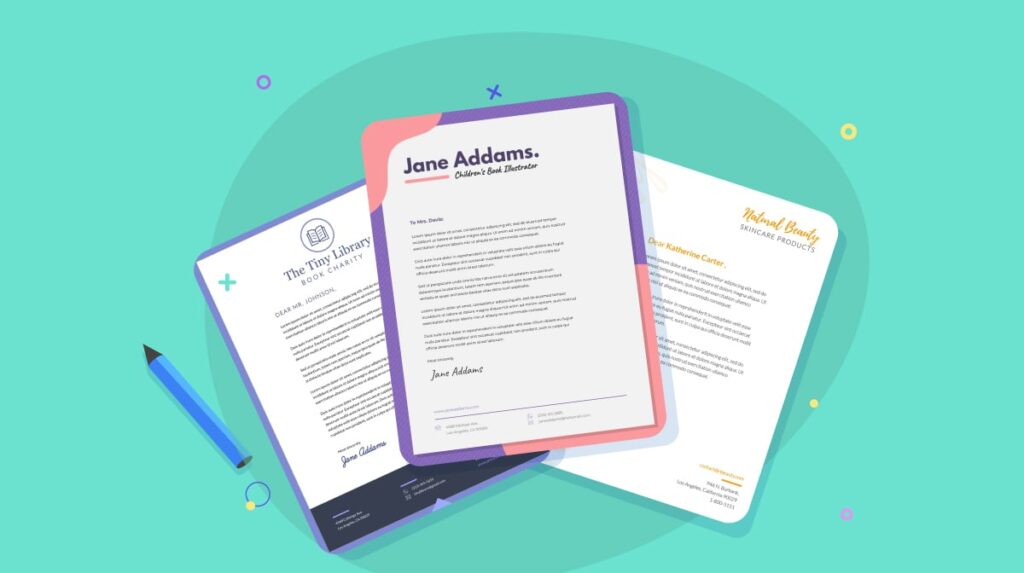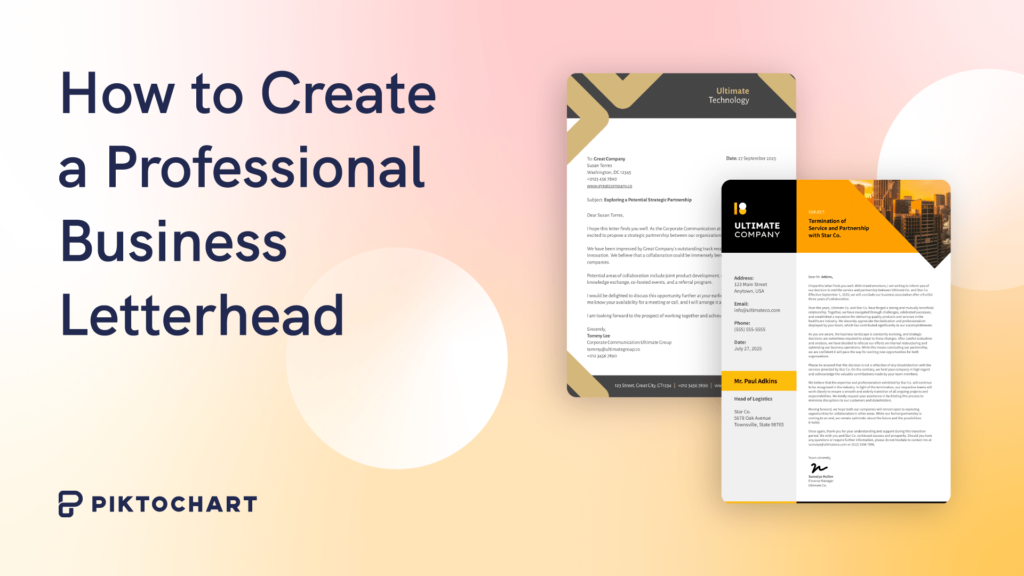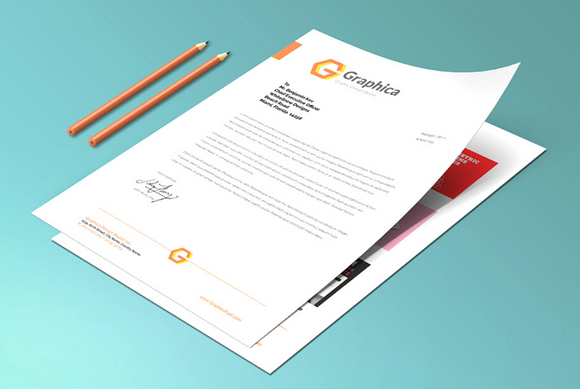Letterheads add a personal touch and can make any communication memorable, helping build trust between clients, employees, and stakeholders. Letterheads provide companies with an opportunity to showcase their logo and contact information – including company name, website address, telephone number, email address and fax number – on custom stationary. Letterhead design should balance clarity with information richness, without distracting readers from the main purpose of communication. A footer can help break up contact info to relieve the strain on the header. Letterhead printing paper makes an impactful statement about its user. While standard uncoated stock offers a traditional white or off-white hue, textured papers such as conqueror may add premium feel and look. Full color printing offers additional possibilities, allowing for more varied shades.

1. Choose a font that is easy to read.
As in emailing or sending birthday cards, legible fonts are key components of effective communication. Letterhead should serve to provide a meaningful platform for written dialogue without detracting from this goal.
Your font selection can have a dramatic effect on how easily your Conqueror Letterheads Printing can be read. Some fonts feature letters that resemble each other closely, such as an “i” and lowercase “l”, or even the number 1 and letter “o”.
These false letters require extra processing from your brain due to their dissimilar appearances, so opt for fonts with generous spacing so the eye can quickly recognize and process characters without exerting additional mental effort – plus this makes the font legible at smaller sizes!
2. Think about ink colors.
Color can leave a lasting impression on your audience. Though seemingly small, selecting an eye-catching ink color for your letterhead will set your business apart from competitors.
Letterhead design should convey information about your company while projecting an image of professionalism, providing an ideal platform to introduce subtle marketing messages.
Letterheads can be an effective way to convey certifications, contact details, and other essential information for your industry. However, be wary of what information is included as too much can overwhelm its purpose and disorient readers.
3. Keep it simple.
Letterhead designs shouldn’t be overly complex or packed with unnecessary information; to keep things straightforward and easy-to-read, highlight only essential information and use a spacious layout so the text stands out clearly.
Your letterhead should contain information such as your company’s name, address, phone numbers(s), and email addresses; additionally it’s important to include details like VAT numbers or registered addresses if applicable.
Add some personality and consistency to your letterhead by including a personal photo or adding accent colors that complement the brand colors. By doing so, you can easily establish a uniform look across other printed materials like business cards and envelopes, helping your company stay consistent while building trust with recipients. Furthermore, custom rubber stamps add another level of professionalism.
4. Add a bit of personality.
Letterhead design goes beyond simply conveying font and layout – it can also communicate your company’s image, identity and personality through subtle color touches or an eye-catching background pattern.
For example, this design incorporates an abstract terrazzo-style pattern to add depth and intrigue – perfect for adding visual interest without diverting attention away from the main text.

Textured backgrounds like linen or laid can give a high-end appearance at a more affordable cost than colored paper stocks, even running through standard office printers for easy production. It is an effective solution for companies that cannot afford full color printing for all their stationery pieces; just make sure that their color scheme remains uniform across each piece in your suite.
5. Add a logo.
Logos make a powerful impactful statement about your company and can add a professional image. A logo also helps the customer remember your business more easily while increasing trust with potential clients. An original design helps your logo set itself apart from competitors.
Your logo should always remain at the top of each page in order to differentiate your business and allow customers to easily find contact information. This helps distinguish you from competitors while simultaneously helping customers easily access all available contact details.
Addition of a footer can help break up contact information and relieve pressure from the header, as well as providing important company details like name and address. Laser guaranteed footers can ensure that your company logo doesn’t rub off onto printed materials.
6. Don’t neglect the reverse side.
Letterheads are personalized stationery designed to promote a company’s branding and contact details, including name, title, address, phone number, email address and logo, along with its brand colors.
Although letterhead designs typically occupy the top third, this doesn’t limit you from using any remaining space to provide additional details – for instance, medical clinics might include information such as their roster of doctors; charitable organizations often list donors or sponsors.
Create an eye-catching letterhead by choosing linen texture paper for your letterheads. This will add an air of luxury, setting you apart from competitors while emphasizing your brand’s artisan or high-end qualities. [1]
7. Keep it professional.
Letterheads can add professionalism and credibility to your documents, while making it easier for employees and clients to locate contact information. In addition, using a professionally designed letterhead ensures all documents produced by your company have an integrated look.
Though including your company logo and contact details is essential, keeping things clear and uncluttered is also vital. A cluttered letterhead may turn readers away or draw their focus away from what matters in your letters.

Selecting high-quality paper for your letterheads is also important, as this can give your documents a more professional appearance and feel better in the hands of recipients. Also important when creating letterheads is considering which fold type will convey information about your company brand image and send the appropriate message to customers.
8. Make sure it’s printed on quality paper.
Letterhead design should exude professionalism and detail that will set you apart from competitors, while also serving to attract new customers and clients.
Print on quality paper when creating a letterhead for your business. In order to ensure durability and attractiveness, consider choosing heavier weight paper to ensure its structural strength in repeated handling.
As another tip, selecting a paper stock that is laser guaranteed can make life much simpler for all types of printers. If you want to take things a step further, adding UV or AQ coatings will protect the printed surface and make colors pop while helping the paper resist water and other liquids better.
9. Add a bit of flair.
Letterhead printing allows businesses to add a personal touch by choosing an eye-catching color scheme or other special touches that stand out and get noticed.
Option two is using special printing effects as a way of adding visualmodo interest and staying true to the purpose of letterheads that contain important information. This approach can add visual appeal while not distracting from their purpose.
Last but not least, you could use a custom watermark to add some flair. Not only is this an effective way of adding some color without taking up too much room; but you could also use this element as a means of emphasizing key information such as company taglines if applicable – something custom watermarks do well.
10. Keep it consistent.
Designing a letterhead requires understanding its intended use and audience. A well-crafted letterhead will help your business stand out and leave an impactful first impression upon potential customers, being easy enough to read while also having its own distinct character and flair.
Your letterhead must include key company information such as its name, address, phone number and email address; additionally you may want to include website and social media handles that relate directly to your business if applicable.
Printing letterheads requires high-quality paper stock to achieve desired results, so selecting one with a smooth finish and professional look will give your stationery an impressive and polished appearance. Also consider opting for unique folds like gate or double gate fold to add even more interest and appeal to the letterheads you print.





